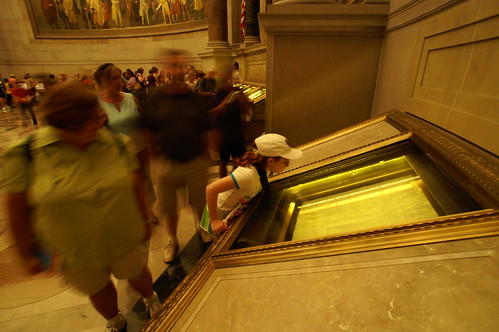One of my favorite museum sites to visit in DC is the National Archives. Housing the original documents from our country’s founding, the National Archives Experience (as it is officially called) always evokes a sense of awe and history in me and many other visitors. And it’s missed by thousands of tourists every year.
People are surprised to find out that there’s more to the Archives than the popular Rotunda. In fact, the entire mission of the Archives is to serve American democracy by safeguarding and preserving the records of our Government, ensuring that the people can discover, use, and learn from this documentary heritage. As such, the National Archives and Record Administration (NARA) was designed to safeguard and preserve the most important documents to American history and our heritage as a country. Thus, NARA serves both the public and the federal government through a network of facilities across the U.S.
Let’s focus on the Archives building here in D.C. There’s a lot more to it than just the popular Rotunda. Did you know there’s a huge Public Vaults exhibit inside the main building on Constitution Avenue? It contains about 1,100 records- documents, photographs, maps, drawings, film and audio clips, all from the foundational fabric of our American democracy. The Vault is a permanent exhibit in the building, with much of the collection rotated through on a slow, periodic basis.
Also within the Archives is the Lawrence F. O’Brien Gallery, a space dedicated to special exhibits. The Gallery recently housed an exhibit of political cartoons from Clifford Berryman, portraying a typical political race from a candidate’s entry into the political process through the
electoral outcome. You can still view the exhibit online.

PICT6238, courtesy of captkodak
The William G. McGowan Theater is a modern 290-seat amphitheater that continuously shows a short film about the Archives and the Charters of Freedom during the Rotunda’s public hours. In the evening, the McGowan hosts various documentary films and other topics related to the Archive’s exhibits and mission.
The Rotunda is the most popular portion of the Archives, as it is home to the Declaration of Independence, the Constitution of the United States, and the Bill of Rights. Flanking the permanent display of the Charters is a rotating exhibit that holds a selection of milestone documents from the Archive holdings. Currently being displayed over this Labor Day week is the Treaty of Paris, which is the original treaty signed by John Adams, Benjamin Franklin and John Jay. The Treaty signified the official end of the Revolutionary War. (It will be the centerpiece of a new exhibit opening in October, “1783: Subject or Citizen?”.)
The National Archives Experience is always free; hours before Labor Day is 10 a.m. – 7 p.m.; after Labor Day is 10 a.m. – 5:30 p.m. The Rotunda is open on Labor Day, but the public records and research rooms are closed for federal holidays.





The Treaty of Paris…I did not know that was at the archives. I love special papers, so I can appreciate the value of aomething like this.
Very interesting. I’m visiting DC in a few weeks for the first time. Very glad I happened upon this post.